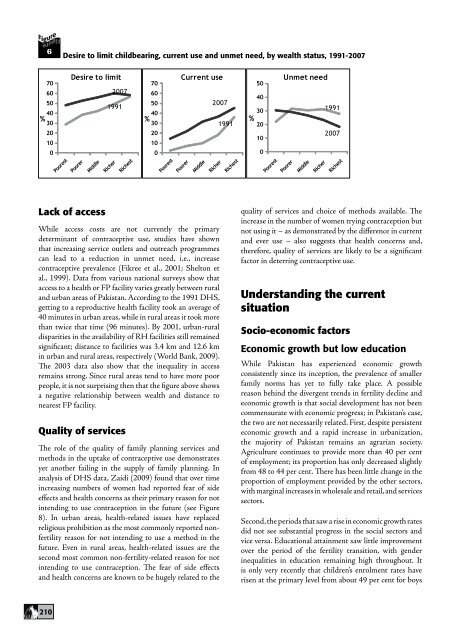Family Planning in Asia and the Pacific - International Council on ...
Family Planning in Asia and the Pacific - International Council on ...
Family Planning in Asia and the Pacific - International Council on ...
Create successful ePaper yourself
Turn your PDF publications into a flip-book with our unique Google optimized e-Paper software.
FigureFigure6Desire to limit childbear<str<strong>on</strong>g>in</str<strong>on</strong>g>g, current use <str<strong>on</strong>g>and</str<strong>on</strong>g> unmet need, by wealth status, 1991-200770605040%3020100PoorestDesire to limit20071991PoorerMiddleRicherRichest70605040%3020100PoorestCurrent use20071991PoorerMiddleRicherRichest504030%20100PoorestUnmet need19912007PoorerMiddleRicherRichestLack of accessWhile access costs are not currently <str<strong>on</strong>g>the</str<strong>on</strong>g> primarydeterm<str<strong>on</strong>g>in</str<strong>on</strong>g>ant of c<strong>on</strong>traceptive use, studies have shownthat <str<strong>on</strong>g>in</str<strong>on</strong>g>creas<str<strong>on</strong>g>in</str<strong>on</strong>g>g service outlets <str<strong>on</strong>g>and</str<strong>on</strong>g> outreach programmescan lead to a reducti<strong>on</strong> <str<strong>on</strong>g>in</str<strong>on</strong>g> unmet need, i.e., <str<strong>on</strong>g>in</str<strong>on</strong>g>creasec<strong>on</strong>traceptive prevalence (Fikree et al., 2001; Shelt<strong>on</strong> etal., 1999). Data from various nati<strong>on</strong>al surveys show thataccess to a health or FP facility varies greatly between rural<str<strong>on</strong>g>and</str<strong>on</strong>g> urban areas of Pakistan. Accord<str<strong>on</strong>g>in</str<strong>on</strong>g>g to <str<strong>on</strong>g>the</str<strong>on</strong>g> 1991 DHS,gett<str<strong>on</strong>g>in</str<strong>on</strong>g>g to a reproductive health facility took an average of40 m<str<strong>on</strong>g>in</str<strong>on</strong>g>utes <str<strong>on</strong>g>in</str<strong>on</strong>g> urban areas, while <str<strong>on</strong>g>in</str<strong>on</strong>g> rural areas it took morethan twice that time (96 m<str<strong>on</strong>g>in</str<strong>on</strong>g>utes). By 2001, urban-ruraldisparities <str<strong>on</strong>g>in</str<strong>on</strong>g> <str<strong>on</strong>g>the</str<strong>on</strong>g> availability of RH facilities still rema<str<strong>on</strong>g>in</str<strong>on</strong>g>edsignificant; distance to facilities was 3.4 km <str<strong>on</strong>g>and</str<strong>on</strong>g> 12.6 km<str<strong>on</strong>g>in</str<strong>on</strong>g> urban <str<strong>on</strong>g>and</str<strong>on</strong>g> rural areas, respectively (World Bank, 2009).The 2003 data also show that <str<strong>on</strong>g>the</str<strong>on</strong>g> <str<strong>on</strong>g>in</str<strong>on</strong>g>equality <str<strong>on</strong>g>in</str<strong>on</strong>g> accessrema<str<strong>on</strong>g>in</str<strong>on</strong>g>s str<strong>on</strong>g. S<str<strong>on</strong>g>in</str<strong>on</strong>g>ce rural areas tend to have more poorpeople, it is not surpris<str<strong>on</strong>g>in</str<strong>on</strong>g>g <str<strong>on</strong>g>the</str<strong>on</strong>g>n that <str<strong>on</strong>g>the</str<strong>on</strong>g> figure above showsa negative relati<strong>on</strong>ship between wealth <str<strong>on</strong>g>and</str<strong>on</strong>g> distance t<strong>on</strong>earest FP facility.Quality of servicesThe role of <str<strong>on</strong>g>the</str<strong>on</strong>g> quality of family plann<str<strong>on</strong>g>in</str<strong>on</strong>g>g services <str<strong>on</strong>g>and</str<strong>on</strong>g>methods <str<strong>on</strong>g>in</str<strong>on</strong>g> <str<strong>on</strong>g>the</str<strong>on</strong>g> uptake of c<strong>on</strong>traceptive use dem<strong>on</strong>stratesyet ano<str<strong>on</strong>g>the</str<strong>on</strong>g>r fail<str<strong>on</strong>g>in</str<strong>on</strong>g>g <str<strong>on</strong>g>in</str<strong>on</strong>g> <str<strong>on</strong>g>the</str<strong>on</strong>g> supply of family plann<str<strong>on</strong>g>in</str<strong>on</strong>g>g. Inanalysis of DHS data, Zaidi (2009) found that over time<str<strong>on</strong>g>in</str<strong>on</strong>g>creas<str<strong>on</strong>g>in</str<strong>on</strong>g>g numbers of women had reported fear of sideeffects <str<strong>on</strong>g>and</str<strong>on</strong>g> health c<strong>on</strong>cerns as <str<strong>on</strong>g>the</str<strong>on</strong>g>ir primary reas<strong>on</strong> for not<str<strong>on</strong>g>in</str<strong>on</strong>g>tend<str<strong>on</strong>g>in</str<strong>on</strong>g>g to use c<strong>on</strong>tracepti<strong>on</strong> <str<strong>on</strong>g>in</str<strong>on</strong>g> <str<strong>on</strong>g>the</str<strong>on</strong>g> future (see Figure8). In urban areas, health-related issues have replacedreligious prohibiti<strong>on</strong> as <str<strong>on</strong>g>the</str<strong>on</strong>g> most comm<strong>on</strong>ly reported n<strong>on</strong>fertilityreas<strong>on</strong> for not <str<strong>on</strong>g>in</str<strong>on</strong>g>tend<str<strong>on</strong>g>in</str<strong>on</strong>g>g to use a method <str<strong>on</strong>g>in</str<strong>on</strong>g> <str<strong>on</strong>g>the</str<strong>on</strong>g>future. Even <str<strong>on</strong>g>in</str<strong>on</strong>g> rural areas, health-related issues are <str<strong>on</strong>g>the</str<strong>on</strong>g>sec<strong>on</strong>d most comm<strong>on</strong> n<strong>on</strong>-fertility-related reas<strong>on</strong> for not<str<strong>on</strong>g>in</str<strong>on</strong>g>tend<str<strong>on</strong>g>in</str<strong>on</strong>g>g to use c<strong>on</strong>tracepti<strong>on</strong>. The fear of side effects<str<strong>on</strong>g>and</str<strong>on</strong>g> health c<strong>on</strong>cerns are known to be hugely related to <str<strong>on</strong>g>the</str<strong>on</strong>g>quality of services <str<strong>on</strong>g>and</str<strong>on</strong>g> choice of methods available. The<str<strong>on</strong>g>in</str<strong>on</strong>g>crease <str<strong>on</strong>g>in</str<strong>on</strong>g> <str<strong>on</strong>g>the</str<strong>on</strong>g> number of women try<str<strong>on</strong>g>in</str<strong>on</strong>g>g c<strong>on</strong>tracepti<strong>on</strong> butnot us<str<strong>on</strong>g>in</str<strong>on</strong>g>g it – as dem<strong>on</strong>strated by <str<strong>on</strong>g>the</str<strong>on</strong>g> difference <str<strong>on</strong>g>in</str<strong>on</strong>g> current<str<strong>on</strong>g>and</str<strong>on</strong>g> ever use – also suggests that health c<strong>on</strong>cerns <str<strong>on</strong>g>and</str<strong>on</strong>g>,<str<strong>on</strong>g>the</str<strong>on</strong>g>refore, quality of services are likely to be a significantfactor <str<strong>on</strong>g>in</str<strong>on</strong>g> deterr<str<strong>on</strong>g>in</str<strong>on</strong>g>g c<strong>on</strong>traceptive use.Underst<str<strong>on</strong>g>and</str<strong>on</strong>g><str<strong>on</strong>g>in</str<strong>on</strong>g>g <str<strong>on</strong>g>the</str<strong>on</strong>g> currentsituati<strong>on</strong>Socio-ec<strong>on</strong>omic factorsEc<strong>on</strong>omic growth but low educati<strong>on</strong>While Pakistan has experienced ec<strong>on</strong>omic growthc<strong>on</strong>sistently s<str<strong>on</strong>g>in</str<strong>on</strong>g>ce its <str<strong>on</strong>g>in</str<strong>on</strong>g>cepti<strong>on</strong>, <str<strong>on</strong>g>the</str<strong>on</strong>g> prevalence of smallerfamily norms has yet to fully take place. A possiblereas<strong>on</strong> beh<str<strong>on</strong>g>in</str<strong>on</strong>g>d <str<strong>on</strong>g>the</str<strong>on</strong>g> divergent trends <str<strong>on</strong>g>in</str<strong>on</strong>g> fertility decl<str<strong>on</strong>g>in</str<strong>on</strong>g>e <str<strong>on</strong>g>and</str<strong>on</strong>g>ec<strong>on</strong>omic growth is that social development has not beencommensurate with ec<strong>on</strong>omic progress; <str<strong>on</strong>g>in</str<strong>on</strong>g> Pakistan’s case,<str<strong>on</strong>g>the</str<strong>on</strong>g> two are not necessarily related. First, despite persistentec<strong>on</strong>omic growth <str<strong>on</strong>g>and</str<strong>on</strong>g> a rapid <str<strong>on</strong>g>in</str<strong>on</strong>g>crease <str<strong>on</strong>g>in</str<strong>on</strong>g> urbanizati<strong>on</strong>,<str<strong>on</strong>g>the</str<strong>on</strong>g> majority of Pakistan rema<str<strong>on</strong>g>in</str<strong>on</strong>g>s an agrarian society.Agriculture c<strong>on</strong>t<str<strong>on</strong>g>in</str<strong>on</strong>g>ues to provide more than 40 per centof employment; its proporti<strong>on</strong> has <strong>on</strong>ly decreased slightlyfrom 48 to 44 per cent. There has been little change <str<strong>on</strong>g>in</str<strong>on</strong>g> <str<strong>on</strong>g>the</str<strong>on</strong>g>proporti<strong>on</strong> of employment provided by <str<strong>on</strong>g>the</str<strong>on</strong>g> o<str<strong>on</strong>g>the</str<strong>on</strong>g>r sectors,with marg<str<strong>on</strong>g>in</str<strong>on</strong>g>al <str<strong>on</strong>g>in</str<strong>on</strong>g>creases <str<strong>on</strong>g>in</str<strong>on</strong>g> wholesale <str<strong>on</strong>g>and</str<strong>on</strong>g> retail, <str<strong>on</strong>g>and</str<strong>on</strong>g> servicessectors.Sec<strong>on</strong>d, <str<strong>on</strong>g>the</str<strong>on</strong>g> periods that saw a rise <str<strong>on</strong>g>in</str<strong>on</strong>g> ec<strong>on</strong>omic growth ratesdid not see substantial progress <str<strong>on</strong>g>in</str<strong>on</strong>g> <str<strong>on</strong>g>the</str<strong>on</strong>g> social sectors <str<strong>on</strong>g>and</str<strong>on</strong>g>vice versa. Educati<strong>on</strong>al atta<str<strong>on</strong>g>in</str<strong>on</strong>g>ment saw little improvementover <str<strong>on</strong>g>the</str<strong>on</strong>g> period of <str<strong>on</strong>g>the</str<strong>on</strong>g> fertility transiti<strong>on</strong>, with gender<str<strong>on</strong>g>in</str<strong>on</strong>g>equalities <str<strong>on</strong>g>in</str<strong>on</strong>g> educati<strong>on</strong> rema<str<strong>on</strong>g>in</str<strong>on</strong>g><str<strong>on</strong>g>in</str<strong>on</strong>g>g high throughout. Itis <strong>on</strong>ly very recently that children’s enrolment rates haverisen at <str<strong>on</strong>g>the</str<strong>on</strong>g> primary level from about 49 per cent for boys210














